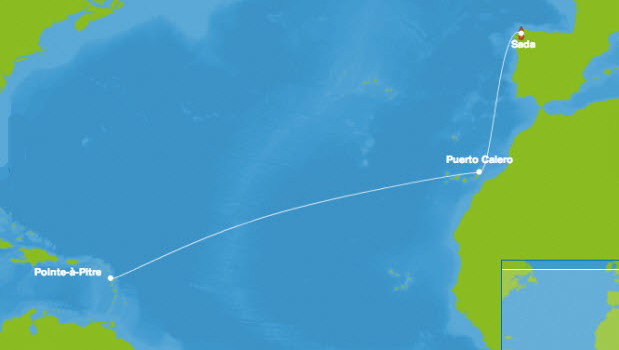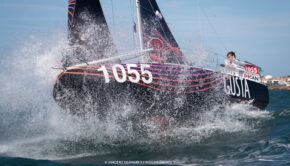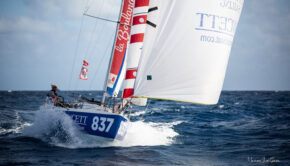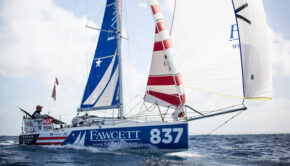Mini-Transat endures one more postponement
Published on November 12th, 2013
(November 12, 2013) – This morning the Mini Transat Race Director posted an amendment regarding a postponement of fifteen hours to the start of the race from Sada to Pointe-à-Pitre. This is expected to be the final delay for the biennial transatlantic race for solo Mini 6.5m competitors that was to start today. The race will now start Wednesday at 0900 local time.
There are two reasons behind this new start: first, according to the race meteorologist, the fleet might encounter strong winds with a risk of winds gusting over 40 knots off Cape Finisterre. More importantly, the passage of a front overnight will cause heavy rain and very low visibility. To send a fleet of over 70 boats out at night into in a high traffic area where many fishing boats do not have AIS was an added complication in the circumstances.
In many ways, given all the incidents and adventures of the Mini fleet since its departure from Douarnenez, this delay is only a small hiccup …
On Wednesday, a powerful north to northeast system awaits the fleet in the early hours of the race. Downwind sails will hoisted and the Minis should quickly be averaging over ten knots. Just like a black run, they will have to negotiate the sheer face of Cape Finisterre where winds can sometimes reach over 40 knots. Then it will be a matter of choice.
Some will prefer to head off to mine a vein of strong winds, which could be in excess of 35 knots. Others will choose to sail south along the coast of Portugal where the winds should traditionally be more manageable. For the competitors and routers (who can still give advice as the soloists have not yet started) alike, it’s a difficult dilemma. Up until what point is it profitable to take advantage of the stronger winds? Especially since sea state has such a direct correlation to the smooth running of these little sleds which are, at the end of the day, only 6.50m long.
Some routing puts the first boats in the Canaries in less than four days and early estimates anticipate an arrival in Guadeloupe after 17 to 18 days of racing for the first prototypes. The first series boats may follow within 48 hours. If this is the case, it will be one of the fastest ever Atlantic crossings, adding a new record to a Mini Transat edition that is already long on superlatives.
Regardless, competitors prefer to work on the basis of 24-25 days at sea. You’re never safe from an incident or a deteriorating weather forecast. Careful management of all supplies is therefore essential to keep within an acceptable weight and ensure good weight distribution inside the boat. In addition to the freeze-dried foods, the sailors have invaded the local supermarket to stock up on some earthly pleasures to keep morale high.
List of Mini Transat 2013 competitors as of 18.00 on 11 November is available here.
Background:
Originally to start from Douarnenez (France) on October 13, the 84 singlehanders were postponed to October 29 due to severe weather. Once started, with the fleet nearly two-thirds across the Bay of Biscay, the race was abandoned due to excessive conditions. The fleet was diverted to Sada, at the north west tip of Spain, to wait for the restart. The race was to have two legs: 1257 miles from France to Canary Islands, and 2764 miles from Canary Islands to Guadeloupe. But now with the delays, the race is reduced to one leg, 3700 miles across the Atlantic from Sada to Pointe a Pitre, with a gate at the Canary Islands for safety.
Race website: www.minitransat.fr









 We’ll keep your information safe.
We’ll keep your information safe.